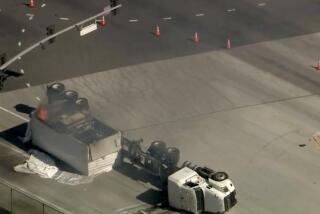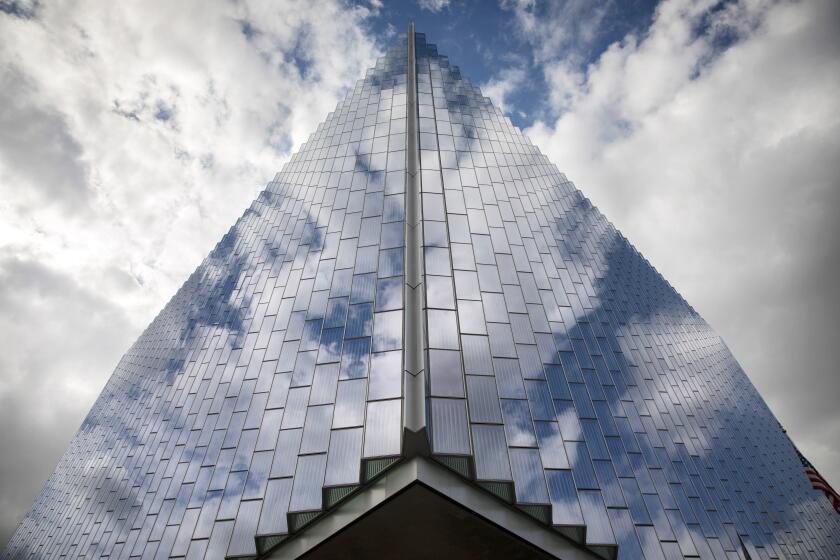MWD Readies Protest as Hope for Canal Fades
The Metropolitan Water District of Southern California is miffed that officials of a state and federal program designed to save the troubled Sacramento-San Joaquin Delta have retreated from an earlier promise to consider building a 44-mile canal.
The canal would loop around the delta to take water directly from the Sacramento River to the California Aqueduct.
MWD board members will meet today in Los Angeles to endorse a letter of protest to the Legislature and officials of the CalFed program.
The blunt letter is a sign that a coalition effort to save the state’s major watershed is now snared in the traditional north-south antagonism over water issues.
Unless the program succeeds in improving the quality and reliability of water shipped to MWD from the delta, “Southern California’s $500-billion economy, quality of life and environment will be threatened,” according to a draft of the letter.
In bypassing the marshy and salty delta, such a canal would allow a higher quality of Northern California water to enter the State Water Project and be sent to Southern California via the aqueduct. MWD takes about 700,000 acre-feet of water a year from the project, enough for more than 5 million people.
Every governor since Goodwin Knight in the 1950s has favored building a canal around the delta but the idea has been killed by passionate and overwhelming opposition in Northern California and, in recent decades, from the environmental movement.
The canal idea was revived earlier this year by CalFed but has now been indefinitely delayed.
MWD believes that CalFed officials know that a canal is the best solution for the delta but are backing down rather than risk confrontation.
“Our concern is that scientific and technical studies are being undermined by political concerns,” said John Foley, MWD board chairman. “That’s just not right.”
Foley and other MWD officials insist that a canal is not meant as a way to get more water. The goal is raising quality, not increasing quantity, they say.
But Tom Graff, an attorney for the Oakland-based Environmental Defense Fund, which opposes a canal, said many Northern Californians believe that the canal would allow Southern California to increase the amount of water it takes from the north even if it means sucking dry the Sacramento River.
He noted that during recent legislative hearings on a San Diego-Imperial Valley water deal that MWD declined an opportunity to voluntarily decrease its entitlement from the State Water Project--currently 2 million acre-feet a year--as a sign of good faith.
“Until they come up with something other than just another ploy to take more water from the north, I don’t think they’ll ever succeed,” Graff said.
MWD, which supplies water to 16 million people in six counties, is the biggest recipient of water from the State Water Project and has expressed concern for years about high salinity and other pollution found in the water being pumped into the aqueduct from the delta.
MWD officials say the high salinity hampers reclamation and recycling efforts, both of which are aimed at reducing the amount of water Southern California takes from Northern California. Desalinization is expensive and creates an environmentally destructive byproduct, brine.
Valerie Holcomb, spokeswoman for CalFed director Lester Snow, said the MWD protest is not unexpected. Other agencies have made the opposite protest.
“Last week we had a hearing in Stockton where people are concerned that CalFed is just a way to get water from the north to the south,” Holcomb said. “Everyone in the process seems to believe CalFed is serving the best needs of somebody else.”
In March, CalFed officials unveiled three alternative plans to improve the delta, which provides drinking water for 22 million people and irrigation for the state’s $25-billion-a-year agricultural industry.
The first two alternatives involved cleaning up tributaries, flood control, siltation control and reclamation. The third alternative was for a Peripheral Canal, which had been redubbed the Open Channel Isolated Facility.
At a series of hearings held to see how the political winds were blowing, CalFed officials were again bombarded by concerns that the canal would encourage reckless water use in the south, the same fears that killed canal proposals in 1964 and 1982.
In mid-June, after a meeting in Sacramento, Gov. Pete Wilson and Secretary of the Interior Bruce Babbitt issued a joint statement emphasizing the urgency in fixing the delta and urging CalFed officials to select from among the three alternatives by year’s end so that work could begin quickly.
But the joint statement also indicated that the idea of a north-south canal around the delta was being put on the back burner in favor of less politically volatile ideas. The statement indicated that a canal might be considered after seven to 10 years, but MWD officials are reading it as a death knell for the idea.
The Wilson-Babbitt statement was a setback for MWD, which has supported the CalFed process, underwritten many of its conservation and planning efforts, and tried to forge a coalition with Northern California cities and Central Valley farmers.
CalFed officials are set to issue the latest in their planning reports next month, with a full environmental report on future plans scheduled for December. MWD officials hope their protest will persuade CalFed to revive the canal proposal.
More to Read
Sign up for Essential California
The most important California stories and recommendations in your inbox every morning.
You may occasionally receive promotional content from the Los Angeles Times.










